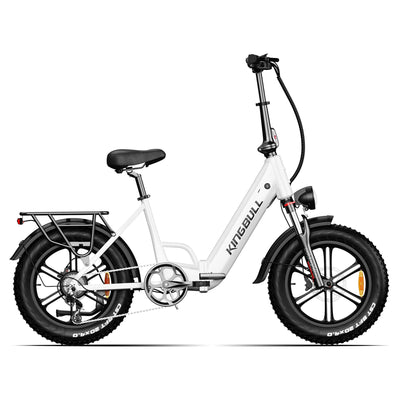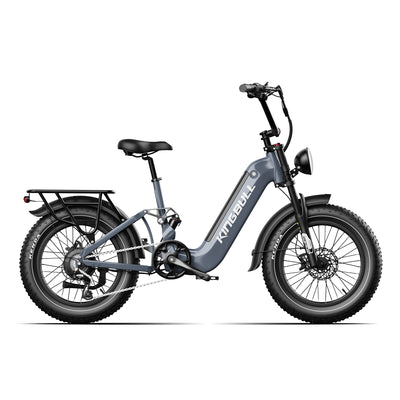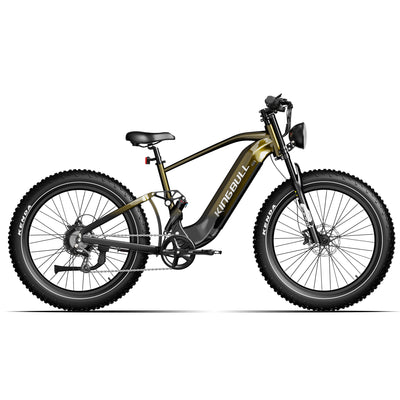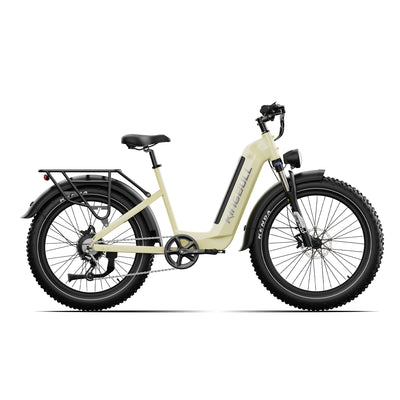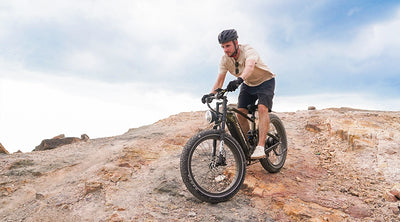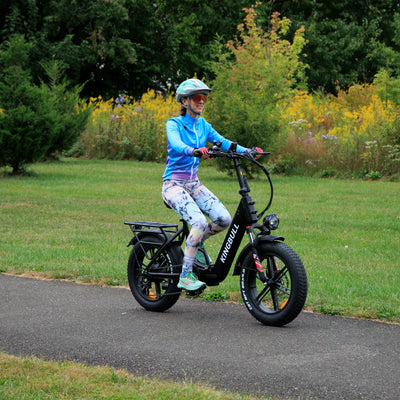Explore News
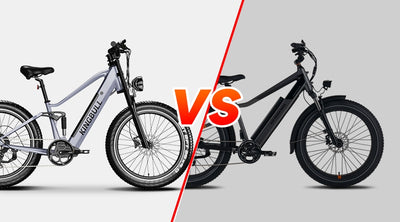
Ebike ComparisonPurchase Guide
Kingbull Rover vs. Rad Power RadRover 6 Plus: Off-Road E-Bike Showdown
In the vast realm of electric bicycles, the powerful off-road models, Kingbull Rover and Rad Power RadRover 6 Plus, have garnered significant attention. This article delves into a thorough comparison of these two remarkable off-road electric bikes, unveiling their differences in performance, design, and adaptability to various terrains. Which one, Kingbull Rover or RadRover 6 Plus, is better suited for your adventurous needs? Let's explore this showdown between off-road electric bikes.
Performance Overview
Rover
RadRover 6 Plus
Motor
48V 750W Brushless Rear Hub
750W brushless geared hub motor
Battery
48V 17.5Ah Lithium Battery
48V 14Ah Lithium Battery
Speed
Up to 28 mph
Up to 20 mph
Range
Up to 60 miles
25-45 miles per charge (estimate)
Pedal Assist
5 Levels
5 Levels
Brakes
Hydraulic
Hydraulic
Throttle
Half Twist
Half twist
Sensor
Cadence
Cadence
Gears
Shimano 7-Speed
Shimano 7-Speed
Weight
77 lbs
73.4lbs
Payload Capacity
440 lbs
275 lbs
Frame
6061 Aluminum Alloy with Internal Battery
6061 Aluminum Alloy with semi-integrated battery
Wheels
26″ x 4″ CST Fat Tires
Kenda Juggernaut 26" x 4"
Soft-tail
Yes
No
Lights
Front: 48V LED Front Headlight
Rear: Integrated taillight with brake light
Front: Standard Rad Power Bikes LED headlightRear: Integrated taillight with brake light
Display
LCD Colorful Screen with USB
2 LCD displays
Step-Over
Yes
Yes
Price
$1,699.00
$2,099.00
Motor & Battery
The Rover and RadRover electric bikes both feature a 48V 750W brushless rear hub motor. This powerful 750W motor not only provides ample power but also offers riders a range of significant advantages. Firstly, the 750W output power allows both these bikes to excel in off-road environments, effortlessly tackling various terrains and complex road conditions, delivering robust and stable power support.
Importantly, in accordance with the regulations of the U.S. electric bike laws, the 750W motor operates within legal standards, ensuring a safe and compliant riding experience for users. This means riders can fully enjoy the potent electric assistance without concerns about regulatory restrictions. This compliance makes the Rover and RadRover ideal choices for diverse environments and requirements, providing riders with greater freedom and flexibility.
The electric bikes Rover and RadRover are equipped with 48V 17.5Ah lithium batteries and 48V 14Ah lithium batteries, respectively. Both of these battery capacities are sufficient to meet the demands of daily commuting. However, Rover boasts a larger battery capacity, providing more robust power support. The larger battery capacity of the Rover makes it an ideal choice for long-distance rides, catering to riders seeking higher speeds and more powerful assistance. This means that in situations requiring extended travel or greater power reserves, the Rover's battery capacity is better suited. Therefore, if you are a rider pursuing long-distance journeys or a higher-speed experience, the Rover's larger battery capacity may better meet your needs.
Speed & Range
In terms of maximum speed, Rover and RadRover present significant differences. Rover has a top speed of 28 mph, while RadRover has a top speed of 20 mph. This means that Rover offers higher performance in terms of speed compared to RadRover.
Rover's top speed of 28 mph provides riders seeking a faster-paced experience with greater flexibility. This is a notable advantage for users who pursue high-speed riding and the quick coverage of distances, especially in urban commuting or situations where a shorter travel time is desired.
On the other hand, RadRover's top speed of 20 mph is suitable for riders who prioritize comfort and stability. This speed is sufficient for general riding needs, particularly in urban environments. For users who lean towards relaxed riding, enjoy the scenery, or seek a more controlled riding experience, RadRover's speed offers a smooth and comfortable riding experience.
Rover boasts a maximum range of 60 miles, while RadRover offers a maximum range of 45 miles. Undoubtedly, due to Rover's larger battery capacity, it outperforms RadRover in terms of riding range. Providing riders with a longer distance, it is suitable for those seeking long-distance adventures or daily commuting over expansive areas, making it an ideal choice for users with such preferences. Although RadRover has a range of 25-45 miles, it still meets general riding needs. This is suitable for urban commuting or short-distance rides in the surrounding environment. While RadRover's range may be relatively shorter, its versatility lies in providing a comfortable riding experience for everyday use.
Brakes
The Rover and RadRover electric bicycles are both equipped with hydraulic brake systems, bringing forth a range of significant advantages compared to traditional mechanical brakes.
Firstly, hydraulic brakes surpass mechanical brakes in braking performance. The hydraulic brake system transmits force through fluid, providing more precise and reliable braking effects. This design enables riders to easily achieve accurate brake control, ensuring prompt stops when needed. In contrast, mechanical brakes may exhibit less stable braking performance due to factors like friction and cable expansion.
Secondly, hydraulic brakes maintain consistent performance in various weather conditions. Compared to mechanical brakes that may be affected by rainwater or mud, hydraulic brakes offer greater stability, ensuring reliable braking effects in different environments. This advantage makes hydraulic brakes particularly beneficial in unpredictable outdoor conditions.
Additionally, hydraulic brakes typically require less manual operating force, allowing riders to brake more effortlessly. This enhanced responsiveness and reduced hand fatigue make hydraulic brakes excel in long-distance rides or challenging terrains. Overall, hydraulic brakes outperform traditional mechanical brake systems in both performance and user experience.
Throttle
Rover and RadRover, two electric bikes designed for off-road adventures, both feature the Half Twist throttle. This design holds significant advantages in the realm of off-road electric bicycles. The Half Twist throttle allows riders to finely adjust the level of electric assistance, providing a more flexible and responsive control experience.
The operating mechanism of the Half Twist throttle permits riders to precisely control the intensity of electric assistance by making subtle adjustments to the position of their fingers. This nuanced control capability makes it easier for riders to navigate diverse terrains and challenges in complex off-road environments, delivering a more detailed and personalized riding experience.
Furthermore, the design of the Half Twist throttle enables riders to react quickly and adapt to ever-changing off-road conditions. With simple adjustments within the Half Twist range, riders can instantly receive responsive electric assistance, facilitating smoother traversals through mountainous terrain, trails, or other challenging landscapes.
In summary, the utilization of the Half Twist throttle in both Rover and RadRover enhances the precision of control and adaptability in off-road environments, providing riders with a more flexible and personalized riding experience. The intuitive control mechanism adds to the joy of riding, while simultaneously improving overall handling performance, making it easier for riders to adapt to various riding conditions.
Sensor
Both the Rover and RadRover electric bicycles feature cadence sensors, which adjust the level of electric assistance by monitoring the rider's pedal cadence. This design ensures a smoother response of electric assistance, delivering a more natural riding experience. Riders won't need to exert excessive effort during cycling, as the system automatically adjusts assistance based on the frequency of pedal cadence, resulting in smoother acceleration and deceleration. This proves particularly beneficial for long-distance rides and urban commuting. The simplicity and reliability of its design provide riders with a more relaxed and natural electric assistance experience.
Weight & Payload Capacity
Rover and RadRover exhibit some noticeable differences. Rover has a total weight of 77 pounds, with a maximum payload capacity of 440 pounds. In comparison, RadRover is lighter, weighing 73.4 pounds, and has a maximum payload capacity of 275 pounds.
This difference may be influenced by several factors, with one major factor possibly being the design and materials of the frame. Such a design allows Rover to be more stable and reliable when carrying heavier loads or passengers.
Frame
Kingbull Rover and RadRover both feature robust and durable 6061 aluminum alloy frames, highlighting their advantages in lightweight construction and strength. However, they differ in battery layout, with Rover adopting an integrated battery design and RadRover opting for a semi-integrated battery. Rover's integrated battery design seamlessly incorporates the battery into the frame, creating a sleek and stylish appearance. This design not only enhances the overall aesthetics of the bike but also provides better protection for the battery, reducing the risk of damage. The integrated battery layout also helps maintain the traditional look of bicycles, offering users a more discreet and integrated battery solution. In contrast, RadRover's semi-integrated battery design slightly protrudes externally, providing users with easier access for maintenance and battery replacement. This design also, to some extent, reduces the complexity of the frame, making battery maintenance more intuitive. The choice between the two designs depends on users' preferences for appearance and battery usability.
Wheels
The Rover and RadRover 6 Plus both feature wide off-road tires, specifically the 26-inch x 4-inch CST Fat Tires and the Kenda Juggernaut 26-inch x 4-inch, respectively. Firstly, the Rover is equipped with 26-inch x 4-inch CST Fat Tires. This fat tire design offers a larger contact area and better floatation, providing excellent traction across various terrains. CST is a well-known tire manufacturer, recognized for durability and reliability, delivering robust performance for riders. In contrast, the RadRover 6 Plus opts for the Kenda Juggernaut 26-inch x 4-inch tires. Kenda, a leading brand in the tire industry, has gained praise for the Juggernaut series, known for outstanding grip and maneuverability. This tire design aims to deliver superior performance in diverse terrains, offering riders increased stability and control. Both tire selections emphasize providing excellent performance in off-road and challenging terrains. Overall, these two wheel options contribute to the reliable performance of these off-road electric bikes.
Soft-tail
The Rover electric bike features a soft tail design, a relatively uncommon feature in electric bikes. Traditionally, soft tail designs are more commonly found in mountain bikes, aiming to provide a more comfortable riding experience. Rover, by incorporating a soft tail, combines the advantages of traditional bicycles to offer riders a smoother and more comfortable riding sensation. The traditional soft tail design in bicycles effectively reduces the transmission of vibrations and bumps to the rider, thereby enhancing the overall riding comfort. In electric bikes, the soft tail also provides better suspension, mitigating the impact of uneven terrain or rough surfaces on the rider's body.
Drawing inspiration from traditional bicycle design principles, Rover, through the use of a soft tail, creates a more comfortable riding experience for cyclists. This design not only sets Rover apart in the electric bike market but also underscores a commitment to rider comfort. For those seeking a smoother and more enjoyable riding experience, the introduction of a soft tail undoubtedly represents an advantage for Rover.
Price
In terms of performance, the Rover is not inferior to the RadRover; both have strong capabilities and features in the electric bike market. However, in terms of price, the Rover stands out as a cost-effective option. Priced at only $1699, the Rover is notably more affordable compared to the RadRover, which is priced at $2099.
This means that, despite the Rover's performance being on par with the RadRover, its cost-effectiveness makes it the ideal choice for users seeking an outstanding riding experience. Whether in motor performance, battery life, or other key aspects, the Rover can meet the demands for a high-performance electric bike and is presented to riders at a more budget-friendly price.
Conclusion
Taking a comprehensive view, both the Kingbull Rover and RadRover 6 Plus showcase unique features in the electric bike market. Whether it's the powerful 750W motor, compliant electric assist system, superior braking performance, flexible throttle design, or the well-designed suspension system and all-terrain tires, each aspect caters to the diverse needs of riders. The Rover stands out with a larger battery capacity and higher maximum speed, catering to users seeking high performance and long-distance rides. On the other hand, the RadRover, with its lighter design and comfortable speed, suits riders looking for leisure and stability. In the end, regardless of the choice, both bikes offer ideal companionship for rides on city roads or rugged mountain trails.
Read more

Ebike ComparisonPurchase Guide
Kingbull Voyager vs. Rad Power RadRunner 3 Plus: Cargo E-Bike Showdown
In the ongoing revolution of urban transportation, cargo electric bikes have become integral in providing users with efficient and environmentally conscious solutions. This mode of transportation not only tackles urban congestion but also underscores the importance of sustainable development. In this article, we will delve into a comparative analysis between the Kingbull Voyager and Rad Power RadRunner 3 Plus, shedding light on these two cargo electric bikes by scrutinizing their design and performance aspects. The objective of this comparison is to empower readers with a comprehensive understanding, aiding them in making well-informed decisions to meet their daily commuting requirements.
Performance Overview
Voyager
RadRunner 3 Plus
Motor
750W
750W
Battery
48V 17.5AH
48V 14AH
Speed
28 MPH
25mph
Range
Up to 60 miles
Up to 45 miles
Pedal Assist
5 Levels
5 Levels
Brakes
Hydraulic
Hydraulic
Throttle
Thumb Throttle
Half twist throttle
Sensor
Speed
Torque
Gears
Shimano 7-Speed
Shimano 7-Speed
Weight
77 lbs
77 lbs
Payload Capacity
440 lbs
350 lbs
Frame
6061 Aluminum Alloy with Internal Battery
6061 Aluminum Alloy with semi-integrated battery
Wheels
20″ x 4″ CST fat tires
20″ x 3.3″ Kenda K905 tires
Light
48V LED Front Headlight,taillight with brake light
LED headlight, taillight with brake light
Price
$1,199
$2,099
By comparing the data in the table, we will conduct a thorough analysis and comparison of the two cargo electric bikes, the Kingbull Voyager and the Rad Power RadRunner 3 Plus. Through these comparisons, we will delve into their key features to assist prospective buyers in making informed decisions, ensuring that consumers choose the electric bike that best suits their needs.
Motor & Battery
Both electric bikes are equipped with powerful 750-watt motors, complying with the regulations of the U.S. electric bike laws to ensure the maximum power is safely achieved. In terms of battery capacity, the Kingbull Voyager stands out. The Voyager has a battery capacity of 48V 17.5Ah. In comparison, the official data for the Rad Power RadRunner 3 Plus indicates a battery capacity ranging from 589-672 Wh, approximately equivalent to 14Ah when converted. While this is still a considerable battery capacity, it may be slightly less than the Voyager's single battery capacity.
It's worth noting that the Kingbull Voyager also offers the option of a dual-battery setup, providing consumers seeking longer range with a more flexible choice. With the dual-battery configuration, the Voyager can achieve a range of up to 100 miles, offering greater convenience for users requiring an extended riding distance. This significant advantage in battery performance positions the Voyager as a suitable choice for riders who prioritize extended range capabilities.
Speed & Range
The Kingbull Voyager boasts a maximum speed of 28mph. According to the regulations of the U.S. bicycle laws, Voyager's speed meets legal standards in many regions and can even provide a higher speed within legal limits. It's essential to adjust the speed according to local bicycle regulations during rides to ensure safety and compliance.
In comparison, the Rad Power RadRunner 3 Plus has a maximum speed of 25mph. While it may not match the speed of the Voyager, considering safety factors, it remains a good choice in many areas.
Regarding the riding range, the Kingbull Voyager offers a maximum range of 60 miles, whereas the Rad Power RadRunner 3 Plus provides 45 miles. Due to the larger battery capacity of the Voyager, there is no doubt that the Voyager excels in the riding range, offering users a longer distance for their rides. This makes the Voyager a superior choice for those seeking longer journeys.
Brakes & Throttle
Voyager and Rad Power RadRunner 3 Plus both feature Hydraulic brakes, highlighting a shared commitment to advanced braking technology. Hydraulic brakes bring several advantages to the table. Firstly, they offer enhanced braking performance with precise control and modulation. The hydraulic system transmits force more efficiently, translating to quicker and more reliable stopping power.
Moreover, hydraulic brakes are known for their consistent performance in various weather conditions. Unlike mechanical brakes that may be affected by cable stretch or environmental factors, hydraulic systems provide reliable braking even in adverse situations, ensuring rider safety.
Additionally, hydraulic brakes typically require less manual effort to operate, contributing to a more comfortable riding experience. The system's responsiveness and reduced hand fatigue make it particularly advantageous during extended rides or in challenging terrains. Click here to learn more about the differences between mechanical brakes and hydraulic brakes.
The focus of comparison now shifts to the throttle systems, with Voyager opting for a thumb throttle, while Rad Power RadRunner 3 Plus employs a half twist throttle. These two designs largely depend on personal preference, and the following will outline the respective advantages of each throttle type.
The advantage of the thumb throttle lies in its convenience of operation. Positioned at the top of the handlebar, riders can easily control the throttle with their thumb without adjusting their grip on the handlebar. This design is particularly popular for long rides as it reduces hand fatigue, enhancing overall riding comfort.
In contrast, the half twist throttle design emphasizes finer control. Typically situated on the side of the handlebar, it controls the throttle by twisting a portion of the handlebar. This design allows riders to have more precise control over acceleration and speed adjustments, suitable for scenarios that demand more flexible control.
In summary, the thumb throttle emphasizes simplicity and comfort in operation, while the half twist throttle focuses on nuanced control, ideal for riders with higher demands for speed adjustments. The choice between these throttle types will depend on individual riding preferences and usage scenarios.
Sensor
Voyager utilizes a speed sensor, while RadRunner 3 Plus employs a torque sensor. The choice between these two designs largely depends on personal preference. The following will outline the advantages of each sensor type.
The advantage of a speed sensor lies in providing riders with a smoother and more natural riding experience. This sensor adjusts the electric bike's power output by monitoring the rider's pedal speed, achieving smoother acceleration and deceleration processes. For riders who appreciate the feel of traditional bicycle riding, the speed sensor offers a more intuitive power control.
In contrast, a torque sensor places more emphasis on the rider's force and exertion. By sensing the rider's pedal force, the torque sensor can more accurately adjust the electric bike's assistance level, achieving a power output that better aligns with the rider's needs. This design is suitable for riders seeking more precise and personalized assistance.
In summary, a speed sensor provides a smooth and intuitive riding experience, while a torque sensor focuses on more precise and personalized force control. The choice between these sensor types will depend on individual riding habits and preferences.
Weight & Payload Capacity
Voyager and RadRunner 3 Plus share the same weight, both weighing in at 77lbs. However, in terms of payload capacity, Voyager has a significant advantage. With a payload capacity of 440lbs, Voyager exceeds Rad Power RadRunner 3 Plus, which supports up to 350lbs. Note: The rear seat of Voyager has a maximum weight capacity of 300lbs.
This difference in payload capacity can be attributed to the construction and design of the frames. Voyager's frame construction is optimized to handle a higher load, ensuring greater durability and stability. Therefore, for riders seeking an electric bike with a higher payload capacity, Voyager presents a more favorable option, providing added versatility and suitability for various cargo and rider configurations.
Frame
Voyager's frame is constructed with 6061 aluminum alloy and features an internal battery design, while RadRunner 3 Plus's frame also utilizes 6061 aluminum alloy with a semi-integrated battery. Although both use the same 6061 aluminum alloy material, the key difference lies in the battery layout.
The primary advantage of the internal battery design is its impact on aesthetics and overall integration. The battery is cleverly embedded within the frame, providing a sleeker appearance without compromising the traditional aesthetics of bicycles. Additionally, the internal battery design offers superior protection for the battery. Being located inside the frame, it is less susceptible to external environmental factors, such as rainwater and dust, compared to external batteries. This helps prolong the battery's lifespan and enhances the overall reliability of the bike in various weather and road conditions.
Voyager's frame adopts an unibody frame design with an elevated rear seat. The advantage of an unibody frame design lies in enhancing the overall stability of the bike. This structure creates a more robust and cohesive riding platform, helping to reduce vibrations and torsion, thereby improving the bike's stability. This is particularly beneficial for riding on various terrains, especially bumpy or uneven surfaces, as it better maintains the stability of the vehicle, providing a more reliable riding experience.
The elevated rear seat design brings additional advantages, primarily in two aspects. Firstly, this design reduces the likelihood of the electric bike tipping over. By raising the rear seat, the inclination angle of the vehicle is minimized, lowering the risk of tipping, especially at low speeds or during stationary moments. Secondly, the elevated rear seat contributes to better maintaining riding balance. This is crucial for maneuvering and overall control, making it easier for riders to handle the vehicle and enhancing the overall safety and comfort of the ride.
Price
Voyager is priced at $1199, while RadRunner 3 Plus is priced at $2099. Undoubtedly, in terms of cost-effectiveness, Voyager holds a clear advantage. Voyager not only leads in terms of pricing but also demonstrates excellent performance. Whether it's motor performance or range, Voyager delivers a satisfying level of capability.
Voyager's design is more user-centric, taking into consideration the needs and comfort of riders. This design focuses on details, enhancing the overall riding experience. In summary, Voyager not only competes strongly in terms of price but also provides riders with a more comprehensive choice in terms of performance and design.
Conclusion
Both Voyager and RadRunner 3 Plus exhibit distinct advantages, making them excellent choices. However, in terms of performance and cost-effectiveness, Voyager stands out. With a more budget-friendly price, Kingbull Voyager offers riders a comprehensive selection, catering to those seeking high performance as well as those prioritizing affordability. Therefore, if you are looking for an electric bike with outstanding performance and reasonable pricing, Voyager is undoubtedly a preferred choice worth considering.
Read more
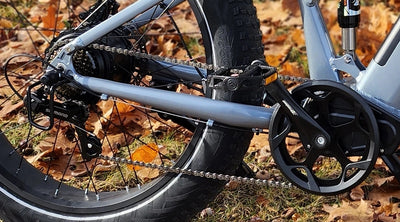
MaintenanceTips & Cycling Knowledge
Electric Bike Chain Care Guide: Maintenance Secrets for Prolonged Life and Enhanced Performance
When you own an electric bike, maintaining the optimal condition of its chain is crucial. The chain serves as the core of the electric bike's power transmission system, directly impacting the efficiency and smoothness of your ride. However, due to factors such as dust, humidity, and other natural elements encountered during daily rides, the chain is susceptible to contamination and wear. To ensure your electric bike consistently performs at its best, we present a comprehensive guide to chain maintenance and care. From simple cleaning techniques to regular lubrication recommendations, this guide will assist you in ensuring the good health of your electric bike's chain, allowing you to experience enhanced performance during your rides.
Why Chain Maintenance Is Necessary
Linking the need for chain maintenance to the performance and lifespan of an electric bicycle emphasizes the critical role of regular upkeep in maintaining an optimal riding experience. The chain is a fundamental component of the electric bicycle's power transmission system, directly influencing the smoothness of rides and overall performance. Regularly maintaining the chain not only ensures the proper functioning of the mechanical components of the electric bicycle but also significantly extends the overall lifespan of the vehicle. With increasing riding mileage, the chain is susceptible to external environmental factors, dust, and moisture, leading to contamination and wear. Through routine maintenance, we can effectively reduce friction resistance in the chain, improve power transmission efficiency, and thereby enhance the overall performance of the entire bicycle.
Good chain maintenance not only impacts riding comfort and efficiency but also directly contributes to the overall safety of the electric bicycle. In cases where the chain is damaged or significantly worn, it may lead to unexpected failures during rides and potentially harm other components of the transmission system. Therefore, incorporating chain maintenance into a regular maintenance routine is a necessary step to ensure the long-term efficient operation of the electric bicycle, providing riders with a more reliable, smooth, and safe riding experience.
Cleaning Frequency and Steps for the Chain
Cleaning the chain is a crucial step in maintaining an electric bike, directly impacting the smoothness of rides and the lifespan of the chain. Here are more detailed recommendations regarding the frequency and steps for cleaning the chain:
Frequency of Cleaning the Chain
The frequency of cleaning the chain should be determined based on the following factors:
Riding frequency: If you ride frequently, the chain is more exposed to dust, mud, and moisture, requiring more frequent cleaning.
Environmental conditions: Riding on muddy paths or in damp weather makes the chain more susceptible to contamination, necessitating more frequent cleaning.
Seasonal changes: In wet seasons, the chain is more prone to moisture, requiring more regular checks and cleaning.
In general, it is recommended to clean the chain every two weeks to a month. If your riding environment is more challenging, more frequent cleaning may be necessary.
The Steps to Clean the Chain
Cleaning the electric bike chain is a crucial step in maintaining the bike's overall condition. Here is a detailed guide on the steps and techniques for cleaning the chain thoroughly:
Preparation
Prepare Chain Cleaning Tools: If you have specialized chain cleaning tools, fill them with bicycle-specific degreaser. Wrap the tool around the chain following the instructions, ensuring the storage compartment is in the correct position. If you don't have specialized tools, you can use a brush (toothbrush or nail brush) as an alternative.
Pre-select Lubricant: Depending on the riding environment, choose between wet lubricant or dry lubricant to ensure effective lubrication under different conditions.
Removing Oil Stains from the Chain
Apply Degreaser: If using specialized tools, add degreaser to the tool. Then, use your other hand to backpedal, allowing the tool's brush to clean all corners and crevices of the chain while collecting degreaser in the storage compartment.
Use Brush for Cleaning: If you don't have specialized tools, apply degreaser to a brush (toothbrush or nail brush). Keep the brush on the top of the chain and then backpedal. Repeat this process on the bottom of the chain, ensuring you clean the chain links under the drivetrain.
Rinsing the Chain
Wash with Soapy Water: Use soapy water to wash the chain, ensuring the removal of excess degreaser and impurities.
Selecting and Lubricating the Chain
Choose Lubricant: Depending on the riding conditions, choose between wet or dry lubricant.
Apply Lubricant to the Chain: Carefully apply a small drop of lubricant to the top of each section of the chain. Ensure the lubricant aligns precisely with the rollers for optimal lubrication.
Wipe Off Excess Lubricant: Use a cleaning cloth to wipe off any excess lubricant from the chain, ensuring the chain's surface is dry.
Following these steps and techniques will ensure that your electric bike chain stays clean, lubricated, and prolongs its lifespan, enhancing overall riding efficiency and comfort.
Checking and Replacing the Chain
Regularly checking and replacing the chain ensures optimal performance of your bicycle and minimizes the potential impact of chain wear on other components.
Checking the Chain
Check Chain Tension: Ensure the chain tension is moderate. Too loose a chain may lead to chain derailment, while excessive tension can increase wear on gears and the chain.
Inspect Chain Wear: Examine the chain for visible signs of wear, such as elongation of chain links or teeth embedding into chainrings. Excessive wear may necessitate replacement.
Measure Chain Tension: Use a chain tension gauge to measure the tension of the chain. This helps determine if the chain is still within the normal working range.
Observe Chain Deformation: Pay attention to whether the chain is twisted or deformed. Deformation may indicate damage to the chain.
Check Chain Links: Ensure that the chain's connecting links or pins are not loose or missing. Any damaged links may lead to chain failure.
Replacing the Chain
Prepare Tools: Ensure you have the necessary tools, such as a chain breaker, chain quick-link tool, and a wrench.
Remove the Old Chain: Use a chain breaker or chain quick-link tool to remove the old chain from the bicycle.
Measure the New Chain Length: Use the new chain and ensure its length is suitable for your bicycle. You can use a chain breaker to adjust the length.
Install the New Chain: Attach the new chain to the bicycle, ensuring the correct connection of each chain link.
Adjust Chain Tension: According to the bicycle manufacturer's recommendations, adjust the tension of the new chain. Typically, you should maintain the chain slightly slack but not too loose or tight.
Connect the Chain: Use a chain quick-link tool or connecting pin to join the chain.
Lubricate the Chain: After installing the new chain, lubricate it to ensure smooth operation. Choose an appropriate lubricant and apply it to each link of the chain.
Test: After replacing the chain, conduct a brief test ride to ensure everything is functioning correctly.
Conclusion
Maintaining your electric bike's chain is not just about preserving a crucial component; it's a commitment to a smoother, safer, and more enjoyable riding experience. The comprehensive guide provided here, from understanding why chain maintenance is necessary to the intricacies of cleaning, lubricating, and replacing the chain, empowers you to take control of your electric bike's health.
Read more

Cycling Trends: In-Depth Analysis of the Benefits of Fat Tire Electric Bikes
Fat tire electric bikes have emerged as a prominent trend in the cycling world, combining the best of both electric and off-road biking experiences. In this analysis, we will delve into the numerous advantages that make fat tire electric bikes a popular choice among cycling enthusiasts.
Definition of Fat Tire Electric Bikes
Fat tire electric bikes are a type of electric bicycle equipped with exceptionally wide tires. In comparison to traditional bicycles, fat tire electric bikes typically feature tires with a width of 4 inches or more. This design is intended to provide a larger contact surface, enhancing stability and traction across various terrains and challenging environments. The design of fat tire electric bikes makes them suitable for a variety of scenarios, including off-road adventures, beach rides, snow traversing, and other riding environments with unique challenges.
What Are The Benfits of Fat Tires?
Fat tires on bikes, particularly fat-tire electric bikes, come with several benefits, making them suitable for various riding conditions. Here are some advantages of fat tires:
Reduce resistance
Fat tires excel in reducing resistance and enhancing overall performance. With a larger surface area in contact with the ground, these tires provide increased stability, making them ideal for challenging terrains like sand, snow, or mud. The expanded contact area distributes the rider's weight evenly, minimizing the risk of slipping or skidding and ensuring a solid foundation. This not only boosts rider confidence but also guarantees a safer and more enjoyable cycling experience, especially in unpredictable conditions. Whether navigating sandy dunes, snowy trails, or muddy paths, fat tires offer enhanced stability for a thrilling and secure ride. Additionally, the wider footprint of fat tires improves traction on loose or slippery surfaces, providing riders with greater control and safety. Conquering diverse landscapes, from sandy beaches to snowy trails, becomes a secure and exhilarating experience, thanks to the reliable grip and stability offered by fat tires.
Versatility Across Terrains
Fat tires excel on a myriad of terrains, exhibiting exceptional performance on surfaces ranging from sandy beaches and snowy landscapes to challenging rocky trails and muddy paths. The robust adaptability of fat-tire bikes makes them an ideal choice for riders who relish the thrill of exploring diverse and unpredictable landscapes. Whether you're embarking on an adventure through sunlit dunes or conquering snow-covered trails, fat tires ensure a reliable grip and stability, enhancing the joy of cycling across various environments. This unparalleled versatility caters to the adventurous spirit, inviting riders to embrace the freedom of exploration and embrace the unexpected challenges of every unique terrain.
Comfortable Ride
The increased volume of air in fat tires acts as a natural suspension system, absorbing shocks and vibrations. This results in a more comfortable ride, reducing the impact on the rider when encountering bumps or uneven surfaces. Additionally, the enhanced shock absorption provided by fat tires contributes to less fatigue during long rides, allowing cyclists to enjoy extended journeys with ease. Whether cruising through city streets or tackling off-road trails, the added comfort ensures a smoother and more enjoyable riding experience for cyclists of all levels.
Floatation on Soft Surfaces
The wide tires distribute the bike's weight over a larger area, preventing it from sinking into soft surfaces like sand or snow. This "floatation" effect enables riders to traverse surfaces that would be challenging for standard bikes. Additionally, this buoyancy makes fat tire electric bikes an excellent choice for beach rides, where the tires effortlessly skim over sandy shores, providing a unique and enjoyable cycling experience. The ability to float on soft terrains not only expands the range of exploration but also adds an element of fun and adventure to your biking endeavors. So, whether it's a snow-covered trail or a sandy beach, your fat tire electric bike ensures a smooth and delightful ride, making every journey a memorable escapade.
Improved Shock Absorption
Fat tires provide better shock absorption, contributing to a significantly smoother and more enjoyable ride. This feature becomes particularly advantageous when riding on rough or uneven terrains, as it not only reduces the impact on the rider's body but also minimizes fatigue and discomfort during extended journeys. The enhanced shock absorption of fat tires ensures that bumps and uneven surfaces are absorbed with greater efficiency, allowing riders to maintain better control and stability throughout their adventures. This added comfort factor makes fat tire bikes an ideal choice for those seeking a ride that seamlessly combines thrill and comfort, even in the most challenging riding conditions.
Durable Materials
Fat tires are typically made from durable and wear-resistant rubber materials to ensure their longevity in various riding conditions. These tread materials exhibit excellent durability, capable of withstanding friction and wear on a variety of surfaces. The structural design of fat tires emphasizes durability, aiming to reduce the risk of damage and wear, thereby extending their lifespan. Therefore, fat tires not only deliver outstanding riding performance but also boast a longer lifespan, making them a durable choice for bicycle tires.
Purchase A Fat Tire Electric Bike From Kingbull
Fat tire electric bikes, renowned for their versatility and enhanced riding experience, have emerged as a popular choice among cycling enthusiasts. To guide you through the array of options available, I am excited to introduce two exceptional fat tire electric bikes from Kingbull. These bikes not only showcase excellent technology and top-tier performance but also cater to a diverse range of riding preferences. Prepare to elevate your cycling adventures with Kingbull's fat tire electric bikes, where innovation meets convenience, offering a ride like no other.
Kingbull Voyager
Features
48V 17.5Ah lithium-ion battery
750W (Sustained), 48V Brushless Rear Hub Motor
28 MPH and Up to 60 miles
5 Levels Pedal Assist and 7-speed gear shift system
Reflective stripe tires, CST, custom 20" x 4.0"
LCD Colorful screen with USB
48V LED Front Headlight
Unibody frame and wheel design
Raised rear rack seat
Kingbull Rover
Features
48V 17.5Ah lithium-ion battery
750W (Sustained), 48V Brushless Rear Hub Motor
28 MPH and Up to 60 miles
5 Levels Pedal Assist and 7-speed gear shift system
Reflective stripe tires, CST, custom 26" x 4.0"
LCD Colorful screen with USB
48V LED Front Headlight
Soft-tail Design
Conclusion
The surge in fat tire electric bikes represents a dynamic shift in the cycling realm, ingeniously blending the thrill of electric biking with the versatility of off-road adventures. Characterized by their exceptionally wide tires, these bikes offer a range of advantages appealing to both novices and seasoned riders. Whether you seek off-road excitement, beach leisure, or urban comfort cruising, Kingbull's fat tire electric bikes redefine the cycling experience. Embrace the thrill, explore the unknown, and embark on a journey of discovery with Kingbull's fat tire electric bikes.
Read more
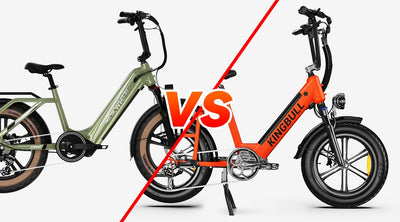
Ebike ComparisonPurchase Guide
Electric Bikes Face-off: A Comparative Analysis of Cargo E-bike Kingbull Voyager vs. Mokwheel Scoria
In the current transformation of urban transportation, cargo electric bikes are playing an increasingly crucial role, providing users with efficient and eco-friendly solutions. This mode of transportation not only addresses urban congestion issues but also emphasizes sustainable development. In this article, we will compare the Kingbull Voyager and Mokwheel Scoria, offering readers a comprehensive understanding of these two cargo electric bikes by evaluating their design and performance. This comparison aims to assist readers in making a more informed choice for their daily commuting needs.
Performance Overview
Voyager
Scoria
Motor
750W
750W
Battery
48V 17.5AH
48V 19.6AH
Speed
28 MPH
25 MPH
Range
Up to 60 miles
60~80miles
Pedal Assist
5 Levels
5 Levels
Brakes
Hydraulic
Hydraulic
Throttle
Thumb Throttle
Thumb Throttle
Sensor
Speed
Torque
Gears
Shimano 7-Speed
Shimano 7-Speed
Weight
77 lbs
79 lbs
Payload Capacity
440 lbs
350 lbs
Frame
6061 Aluminum Alloy with Internal Battery
6061 Aluminum Alloy with Internal Battery
Wheels
20″ x 4″ CST fat tires
20x4.0" CHAOYANG ARISUN Fat Tire
Light
48V LED Front Headlight
Dual-Bulb Brilliance
Display
LCD Colorful Screen with USB
LED Integrated
Price
$1,199
$1,799.00
Next, based on the table contents, we will provide a detailed and comprehensive overview of the performance of the Voyager and Scoria electric bikes. By comparing these key performance indicators, we will delve into the strengths and features of these two electric bikes, offering insights into their performance aspects. This comparison aims to provide readers with a comprehensive perspective, aiding in a better understanding of their performance in various aspects. Such a comparison will offer you a well-rounded view, assisting you in gaining a more comprehensive understanding of these two electric bikes.
Motor & Battery
Both models are equipped with high-performance 750W motors, providing users with robust power support. The 750W motor not only handles various complex urban riding conditions but also ensures sufficient power during starts and climbs, enhancing the overall riding experience. Its excellent performance enables users to navigate through the city more easily and swiftly.
Regarding the battery, the Voyager is powered by a 48V 17.5Ah battery, while the Scoria comes with a 48V 19.6Ah battery. Both batteries represent outstanding endurance, meeting the demands of users for long-distance rides. The combination of a 750W motor and high-capacity battery not only delivers strong power output but also extends the overall range, allowing users to confidently plan extended journeys. Although the Voyager currently features a 48V 17.5Ah battery, we are continuously working to enhance product performance, and in the future, we will further increase battery capacity for even better endurance.
Speed
In terms of speed, the Voyager excels with a top speed reaching 28mph. This design not only satisfies riders' desire for high-speed cycling but also takes into consideration the maximum speed limits in some U.S. states, set at 28mph. The Voyager's design aligns closely with practical needs, allowing riders to effortlessly reach their desired speeds in various states. Of course, while emphasizing speed, we always prioritize safety, ensuring users enjoy outstanding safety assurance even during high-speed rides.
In comparison, the Scoria has a top speed of 25mph. Although still quite fast, it's undeniable that, compared to the Voyager's 28mph, it falls slightly short in speed. Nevertheless, the Scoria continues to provide a swift riding experience.
Range
Voyager and Scoria exhibit their respective unique features. Voyager, based on a single-battery configuration, achieves a riding range of over 60 miles, providing riders with reliable endurance. On the other hand, Scoria, with a larger battery capacity than Voyager, excels in endurance, boasting a riding range of 60 to 80 miles. However, Voyager possesses a unique advantage with its optional dual-battery system. By equipping the dual-battery setup, Voyager effortlessly extends its riding range to over 100 miles. Whether for daily commuting or long-distance rides, users can flexibly adjust based on individual needs, ensuring the optimal riding experience.
Brakes & Throttle
The braking systems of both Voyager and Scoria utilize hydraulic brake technology. Firstly, the hydraulic brake system offers a more responsive and precise response compared to traditional mechanical brake systems. It can transmit braking force in a shorter amount of time, thereby enhancing braking efficiency and safety. Additionally, the hydraulic brake system adapts well to the demands of high-speed driving and emergency braking, ensuring stability in various driving scenarios.
Both Voyager and Scoria feature a thumb throttle, in terms of throttle control, the thumb throttle design provides a more convenient and comfortable driving experience for the driver. Compared to traditional foot pedals, the thumb throttle allows the driver to adjust the throttle opening more naturally during driving without the need to shift foot positions, thereby improving maneuverability. This design is particularly practical for long drives and situations requiring frequent adjustment of vehicle speed, offering a more user-friendly driving experience for the driver.
Sensor
In the realm of sensors, the choice between the Voyager's speed sensor and the Scoria's torque sensor brings forth distinctive characteristics. The speed sensor utilized by the Voyager stands out on level terrains, where it facilitates rapid acceleration to the desired speed with minimal pedal exertion, ensuring a seamless and effortless riding experience. This feature proves advantageous for users who prioritize a smooth commute on even surfaces.
On the other hand, the torque sensor employed by the Scoria demands a more substantial pedal force to modulate the speed. However, it excels in scenarios that necessitate more vigorous and forceful pedaling efforts, such as climbing hills or accelerating from a standstill. The torque sensor's ability to finely tune the electric assistance based on the rider's applied force leads to a more responsive and personalized riding experience, particularly suitable for those seeking enhanced control and efficiency in varied riding conditions.
Weight & Payload Capacity
In the comparison of electric bikes, weight and load capacity are two crucial performance indicators. The Voyager weighs 77 pounds, providing users with a more agile and convenient riding experience. In contrast, the Scoria is slightly heavier, reaching 79 pounds. The Voyager excels in load capacity, supporting a remarkable 440-pound load, offering users enhanced carrying capability. While the Scoria has a load capacity of 400 pounds, it remains sufficient for most daily transportation needs.
Frame
Both the Voyager and Scoria electric bikes feature robust 6061 aluminum frame construction and an integrated battery design, seamlessly blending the battery into the overall frame to enhance structural integrity. This design not only ensures a more compact battery placement but also contributes to a sleeker overall appearance.
The Voyager boasts an upgraded rear-seat frame design and a unibody frame structure. This unique design significantly improves the bike's overall stability, reducing the risk of tipping, especially noticeable on flat surfaces or uphill rides. This distinctive design, particularly beneficial for scenarios requiring extra stability such as cargo transportation or carrying children, makes the Kingbull Voyager a more reliable and secure choice.
In contrast, the Scoria's frame and rear seat are designed separately. Compared to the integrated design of the Voyager, this separation may result in a slightly reduced overall stability. The disjointed frame structure might exhibit lower stability in certain riding scenarios, potentially leading to increased bike sway, particularly when dealing with additional loads or navigating complex terrains.
Wheels
The Voyager is equipped with a pair of 20″ x 4″ CST fat tires, while the Scoria features 20x4.0" CHAOYANG fat tires. Both bikes have opted for the same specifications of 20x4 fat tires, providing riders with enhanced traction and a more comfortable riding experience. The advantages of fat tires lie in their larger contact area and lower tire pressure, effectively mitigating vibrations and delivering a more stable riding sensation. Additionally, fat tires excel on uneven surfaces, offering riders improved maneuverability and traversability.
Although the Voyager and Scoria share the same tire specifications, the Voyager opts for CST tires, whereas the Scoria utilizes CHAOYANG tires. The Voyager tires features an unibody wheel design, this advanced design not only enhances the durability of the tire but also improves the overall performance of the e-bike. Moreover, the integrated wheel design contributes to providing more stable handling, allowing the Voyager to perform exceptionally well on various terrains. This innovative wheel design ensures a smoother, more reliable riding experience.
Light & Display
The Voyager electric bike showcases Kingbull's dedication to innovation and user experience in lighting and display. Firstly, the Voyager is equipped with a powerful pair of 48V LED front headlights. Compared to the headlights of other electric bikes on the market, their larger size provides a wider illumination range, offering riders a clearer and brighter vision. This design not only enhances safety during nighttime rides but also helps users adapt to various road conditions.
In terms of instrumentation, the Voyager features a colorful LCD screen with a built-in USB charging port. This full-color screen design not only enriches the display of vehicle information but also increases interaction between the user and the bike. Additionally, the built-in USB charging port provides a convenient mobile charging function for riders, especially during outdoor activities, addressing the issue of low phone battery and ensuring communication tools always have ample power.
In comparison, the Scoria is equipped with Dual-Bulb Brilliance front headlights and an LED Integrated dashboard. Their front headlights appear relatively small, potentially indicating a limited illumination range. However, the dual-bulb design might add a bright spot to their headlights in terms of brightness.
Price
The Voyager is currently priced at $1,799, while the Scoria comes in at $2,299. It's essential to note that these prices represent the regular retail prices. It's worth keeping an eye out for potential discounts or special offers, particularly during holidays or promotional periods.
Conclusion
Whether it's the Voyager or Scoria, both showcase exceptional design and performance. Each bicycle has its unique highlights, meticulously crafted from design aesthetics to actual functionality. Whether embarking on a long journey, utilizing it for practical purposes, or daily commuting, Kingbull Voyager promises an unparalleled riding experience. Kingbull is dedicated to seamlessly integrating electric bicycles into people's daily lives and work, shaping a new lifestyle that prioritizes convenience, efficiency, and environmental consciousness.
LED集成
Read more
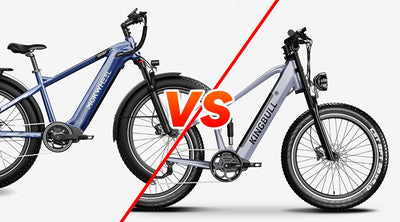
Ebike ComparisonPurchase Guide
Kingbull Rover vs. Mokwheel Basalt: Unleashing the Power of Off-Road Electric Bikes
In the realm of adventure electric bicycles, selecting a model that suits your needs can be as challenging as embarking on an expedition. The market is flooded with electric bikes that emphasize off-road capabilities and the spirit of adventure, and among them, Kingbull and Mokwheel each showcase their unique features. In this article, we will conduct a comprehensive comparison of these two off-road electric bikes, aiming to provide you with a clearer guide for making an informed choice. Whether you're venturing into mountainous terrains or navigating urban adventures, understanding the strengths of Kingbull and Mokwheel will aid you in deciding which model aligns better with your adventurous requirements. Let's delve into the adventure journey of these two electric bikes, exploring their performance in various aspects.
Performance Overview
Rover
Basalt
Battery
48V 17.5Ah Lithium Battery
Samsung 48V 19.6Ah
Motor
48V 750W Brushless Rear Hub
48V 750W Brushless Rear Hub
Speed
Up to 28 mph on Level 5 PAS
Up to 28 mph on Level 5 PAS
Range
Up to 60 miles
60-80 Miles
Pedal Assist
5 Levels
5 Levels
Brakes
Hydraulic
Hydraulic
Throttle
Half Twist
Thumb
Sensor
Speed
Torque
Gears
Shimano 7-Speed
Shimano 7-Speed
Weight
77 lbs
79 lbs
Payload Capacity
440 lbs
400 lbs
Frame
6061 Aluminum Alloy with Internal Battery
6061 Aluminum Alloy with Internal Battery
Wheels
26″ x 4″ CST Fat Tires
26''x4.0" CHAOYANG Fat Tire
Soft-tail
Yes
No
Light
48V LED Front Headlight
Dual-Bulb Brilliance
Display
LCD Colorful Screen with USB
LED Integrated
Price
$1,199.00
$1,899.00
Next, we will delve into a detailed comparison of the key features between the Kingbull and Mokwheel electric bikes, as outlined in the table. By thoroughly exploring their performance and functionalities across various aspects, our aim is to provide you with a comprehensive understanding.
Battery
The Rover model is equipped with a high-performance 48V 17.5Ah lithium-ion battery. Although the battery does not utilize a well-known brand, we insist on selecting high-quality battery cells and employing advanced manufacturing processes. This ensures that the Rover's battery not only delivers long-lasting range but also excels in terms of lifespan and stability.
On the other hand, the Basalt model features a 48V 19.6Ah battery from Samsung. The choice of this Samsung battery ensures Basalt's impressive capabilities in terms of range.
Whether it's the Rover or the Basalt, we strive to optimize every detail, ensuring that when users choose a Kingbull electric bike, they receive not only outstanding battery performance but also a comprehensively upgraded riding experience.
Motor
Both the Rover and Basalt electric bikes are equipped with a powerful 48V 750W brushless rear hub motor, in compliance with the electric bike regulations of the United States. The U.S. electric bike regulations stipulate a maximum motor power of 750W, and this design not only meets regulatory standards but also provides riders with excellent power support. Kingbull adheres to the principles of compliance and legality, ensuring users receive outstanding motor power that aligns with local regulations.
Notably, both models opt for a rear hub motor. Rear hub motors offer several notable advantages, with one being a smoother and quieter riding experience. As the motor is integrated into the rear wheel, it eliminates friction and noise from traditional chain and gear systems, resulting in a more tranquil and stable riding experience.
Speed & Range
The Kingbull Rover and Mokwheel Basalt electric bikes both exhibit outstanding performance, especially in terms of top speed and range. Both models can achieve a top speed of 28 miles per hour. We deeply understand the varying regulations across different states in the United States regarding the speed of electric bikes. Therefore, Kingbull insists on providing a top speed of 28 mph to ensure compliance with standards in all states, allowing users to enjoy fast and efficient rides anywhere.
In terms of range, the Rover boasts a maximum range of up to 60 miles, while the Basalt offers an extended range of 60 to 80 miles. This means that whether it's daily commuting or weekend adventures, both the Rover and Basalt can meet users' needs for longer rides, providing riders with more flexible and extensive travel options.
Brakes
Kingbull Rover and Mokwheel Basalt are both equipped with advanced hydraulic brake systems. This system demonstrates outstanding performance in braking, providing riders with excellent control to ensure speed management and safe stopping during rides. It not only delivers powerful braking force but also shows significant improvements in response speed and sensitivity. This allows riders to precisely manage their speed, easily adapting to different road conditions and riding environments, ensuring reliable safety performance.
Compared to traditional brake systems, hydraulic brake systems exhibit exceptional stability and durability, reducing maintenance frequency and enhancing the overall riding experience. Whether in high-speed riding or emergency braking situations, these brake systems can deliver robust braking effects, ensuring riders maintain control over their rides safely and comfortably in any scenario.
Throttle & Sensor
Rover and Basalt showcase distinctly different designs in terms of throttle control. Rover utilizes a Half Twist throttle design, offering off-road riders a more convenient and intuitive operating experience. Particularly in off-road environments, the Half Twist design allows riders to make throttle adjustments more effortlessly and quickly, enhancing maneuverability and response speed. For riders seeking a more exhilarating off-road experience, this design better caters to their need for precise control.
In contrast, Mokwheel's Basalt opts for a Thumb throttle. While this design may be more common in some scenarios, in off-road riding, the Half Twist design aligns better with the rider's need for swift adjustments. The Thumb throttle may require more time and effort to make corresponding adjustments, and comparatively, its maneuverability in off-road conditions may be somewhat limited.
In terms of sensors, the Rover employs a speed sensor, while the Basalt opts for a torque sensor. The speed sensor demonstrates clear advantages on flat surfaces, allowing the rider to quickly reach the target speed with minimal pedal effort, providing a smooth riding experience. In contrast, the torque sensor requires greater pedal force to adjust the speed, but excels in situations that demand more forceful pedaling.
Weight & Payload Capacity
The Rover and Basalt electric bikes excel in their designs concerning weight and load-bearing capacity, providing users with a stable riding experience. The Rover's lightweight design, weighing only 77 pounds, enhances its maneuverability and agility. In comparison, the Basalt, slightly heavier at 79 pounds, still maintains reasonable weight, ensuring overall stability.
In terms of load-bearing capacity, the Rover demonstrates outstanding performance, supporting weights of up to 440 pounds. This means users can not only carry necessary items but also easily share enjoyable riding moments with others. In contrast, the Basalt has a load-bearing capacity of 400 pounds, slightly lower than the Rover but still sufficient for daily riding and carrying items.
Both models showcase robust load-bearing capabilities, providing users with more choices and convenience. Kingbull electric bikes are dedicated to delivering excellent performance in all aspects, meeting users' expectations for diverse travel needs.
Frame & Wheels
Both models feature robust and durable 6061 aluminum alloy frames with integrated battery systems. This design not only enhances the overall sleekness of the appearance but also provides better stability and ruggedness to the electric bikes, ensuring excellent performance in various riding conditions.
Regarding the tires, both the Rover and Basalt adopt a 26*4 fat tire design, offering riders a smoother and more comfortable riding experience. Fat tires have a larger contact area, providing better stability and easy adaptability to various terrains. Additionally, fat tires offer improved shock absorption, delivering a more comfortable riding experience on uneven surfaces. Rover utilizes CST tires, a well-known brand recognized for careful development in tread design and rubber material, offering riders excellent grip and durability. Basalt, on the other hand, opts for Chaoyang tires, known for their high-quality manufacturing processes and outstanding performance, providing reliable tire support for the Basalt model.
Soft-tail
One of the standout features of the Rover electric bike is its distinctive soft-tail design, a relatively rare characteristic among off-road electric bicycles. The soft-tail design proves to be particularly prominent in off-road riding, effectively mitigating bumps and vibrations to provide riders with a smoother and more comfortable cycling experience. In comparison to electric bikes from other brands, Rover, through the clever design of its soft-tail system, delivers superior suspension effects for riders on uneven terrains, instilling confidence to tackle various challenges.
The advantages of the soft-tail system extend beyond comfort; it also contributes to enhanced stability and maneuverability of the vehicle. On steep slopes and rugged mountain trails, the soft-tail system plays a crucial role, allowing riders to better control the bike, maintaining a stable and agile handling.
Light & Display
The Rover electric bike showcases Kingbull's dedication to innovation and user experience in lighting and display. Firstly, the Rover is equipped with a powerful pair of 48V LED front headlights. Compared to the headlights of other electric bikes on the market, their larger size provides a wider illumination range, offering riders a clearer and brighter vision. This design not only enhances safety during nighttime rides but also helps users adapt to various road conditions.
In terms of instrumentation, the Rover features a colorful LCD screen with a built-in USB charging port. This full-color screen design not only enriches the display of vehicle information but also increases interaction between the user and the bike. Additionally, the built-in USB charging port provides a convenient mobile charging function for riders, especially during outdoor activities, addressing the issue of low phone battery and ensuring communication tools always have ample power.
In comparison, the Basalt is equipped with Dual-Bulb Brilliance front headlights and an LED Integrated dashboard. While these are commendable designs, Rover's innovative approach to lighting and display further emphasizes Kingbull's commitment to user needs and safety.
Price
In terms of pricing, Kingbull demonstrates exceptional value for its electric bicycles. The Rover is priced at only $1699, while the Basalt is listed at $2199. This undoubtedly makes the Rover a more affordable option, providing riders with an economical choice for a high-performance electric bike. It's worth noting that during specific promotional periods, the prices of both models are further reduced. This means that users not only get outstanding performance and quality with Kingbull electric bikes but also have the opportunity to enjoy even more budget-friendly prices during promotional events.
Read more

